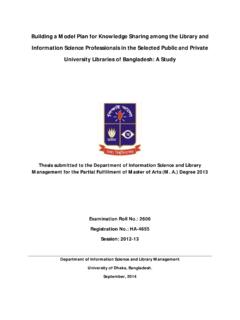Transcription of Design and Development of Digital Library : an initiative ...
1 Design and Development of Digital Library : an initiative at TISS Design and Development of Digital Library : an initiative at TISS Koganuramath and Mallikarjun Angadi Tata Institute of Social Sciences, no. 8313, Sion-Trombay Road, Deonar, Mumbai 400 088, India e-mail: Abstract: Digital Libraries are the systems providing users the organised information access to repository of information and services at knowledge base. Ultimately, it is the demand for high quality content and ease of access and use that will drive the initiation and Development of Digital libraries. The major objectives and principles of Digital Library have been narrated with applied knowledge system at TISS Library . The functional components of the Digital Library have been presented as a model for the information services of the Library .
2 The digitisation activities and procedures are also discussed here. Introduction Libraries form a vital part of the world's systems of education and information storage and retrieval. They make available- through books, films, recordings, and other media- Knowledge that has been accumulated through the ages. People in all walks of life - including students, teachers, business executives, government officials, scholars, and scientists- use Library resources for their research. Large number of people also turn to Library to satisfy a desire for knowledge or to obtain material for some kind of leisure-time activity. In addition, many people enjoy book discussions, and other activities that are provided by their Libraries. The Library of the future will be less a place where information is kept on a portal through which students and faculty will access the vast information resources of the world.
3 The Library of the future will be about access and knowledge-management, not about ownership. The main products of the Library and information professionals in the 21st century will be introduction of the Digital Libraries and the archives. Design and Development of Digital Library : an initiative at TISS Evolution of Digital Collections In 1993, the British Library initiated the "Electronic Beowulf Project" to capture, enhance, and preserve forever this cultural artifact in Digital form. Not only has the manuscript been captured in its current form, but it is now available for study anywhere. This is only one example of how, throughout the world, libraries, museums and archives are digitizing the important documents and images of our culture, both to preserve them for future generations and to make them more accessible to our own.
4 Through the 1990s, Digital Library projects were largely experimental activities. Many important advances in Digital Library techniques came through research sponsored by the National Science Foundation (NSF) and the Joint Information Systems Committee (JISC). In 1999 these projects began expanding internationally when NSF linked its Digital Library research program with similar activities being undertaken by JISC, resulting in the JISC-NSF International Digital Library initiative . The objectives of this three-year program were to: Assemble collections of information that were not otherwise accessible or usable because of technical barriers, distance, size, system fragmentation, or other limits. Create new technology and the understanding to make it possible for a distributed set of users to find, deliver, and exploit such information.
5 Evaluate the impact of this new technology and its international benefits. Since then, many other groups have become involved in the expansion of Digital Library technologies and techniques, including the European Union, Association for Computing Machinery (ACM), the Institute of Electrical and Electronics Engineers (IEEE), the International Federation of Library Associations (IFLA), the American Library Association (ALA), the Coalition for Networked Information (CNI), and the Digital Library Federation (DLF). What is Digital Library ? Digital libraries were viewed as systems providing a community of users with coherent access to a large, Design and Development of Digital Library : an initiative at TISS organized repository of information and knowledge.
6 One group made the provocative proposal that this organization of information was characterized by the absence of prior detailed knowledge of the uses of the information. The ability of the user to access, reorganize, and utilize this repository is enriched by the capabilities of Digital technology. Digital libraries are for the foreseeable future need to span both print and Digital materials and that the central issue was to provide a coherent view of a very large collection of information. In this sense, an emphasis on content solely in Digital format is too limiting. Really, the objective is to develop information systems providing access to a coherent collection of material, more and more of which will be in Digital format as time goes on, and to fully exploit the opportunities that are offered by the materials that are in Digital formats.
7 Additionally, the comprehensiveness and value of the collection accessible through a Digital Library system can be strengthened by the ability to integrate materials in Digital formats that have not been well-represented, easy to access, or effectively usable in traditional Library collections, such as multimedia, geospatial data, or numerical datasets. There is, in reality, a very strong continuity between traditional Library roles and missions and the objectives of Digital Library systems. There are many definitions, ranging from the electronic catalog that describes physical items in a "brick and mortar" Library to advanced multimedia environments housing all- Digital collections. H. Thomas Hickerson, Cornell University's Associate University Librarian for Information Technologies & Special Collections believes that "A major portion of Library activities are technology-supported and have been for years.
8 The Internet has had an incredible impact, but libraries have a history of managing large systems and using technology to deliver bibliographic information," Bernie Hurley, the Director for Library Technologies at Berkeley, draws the distinction between traditional Library automation and Digital libraries. Hurley notes that " Digital libraries are different in that they are designed to support the creation, maintenance, management, access to, and preservation of Digital content." Sun Microsystems defines a Digital Library as the electronic extension of functions users typically perform Design and Development of Digital Library : an initiative at TISS and the resources they access in a traditional Library . These information resources can be translated into Digital form, stored in multimedia repositories, and made available through Web-based services.
9 Major Digital Library projects in India Following are the some of the major Digital Library projects that have been initiated and under operational. The University of Hyderabad became the first institution in India to install the Digital Library Program along with Virtua. The Digital Library initiative was a joint project between VTLS, SUN Microsystems and University of Hyderabad. The University is installing a full Virtua system with the High Resolution Image Navigator to display its Digital content. In addition to the implementation of Virtua, the program calls for the digitization of several hundred books and manuscripts held in the Library . Nalanda (Network of Automated Library And Archives) is the result of the ongoing Digital Library initiative at National Institute of Technology Calicut Library , Kerala.
10 Nalanda Project aims at a full-fledged Digital Library at NITC to cater to the increasing demand for information resources from the Campus User Community as well as from Remote Users from rest of the Country; particularly from the Southern States of India. ICICI Knowledge Park, Hyderbad is world class National R&D infrastructure of the highest standard, developed jointly by Andhra Pradesh Governement, ICICI Bank Limited and Department of Scientific and Industrial Research (DSIR), Government of India. UNIVERSAL Digital Library - a million books to the web, IISC, Bangalore. A project proposal for NSF support under the Indo-US Science and Technology Collaboration initiatives. Digital Library initiative at TISS (DLI) Unlike previous eras, ours is an age of lifelong learning.









